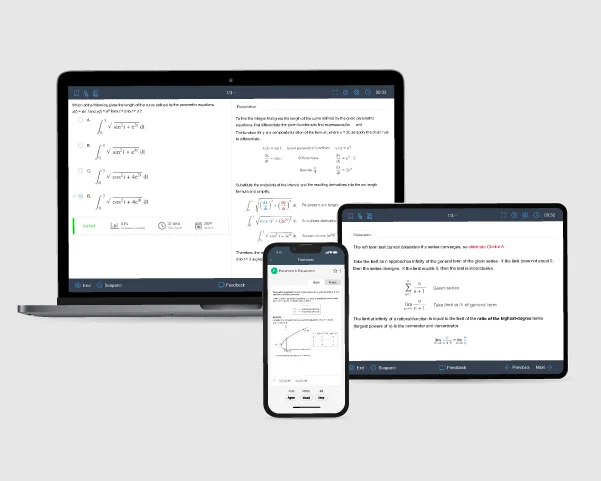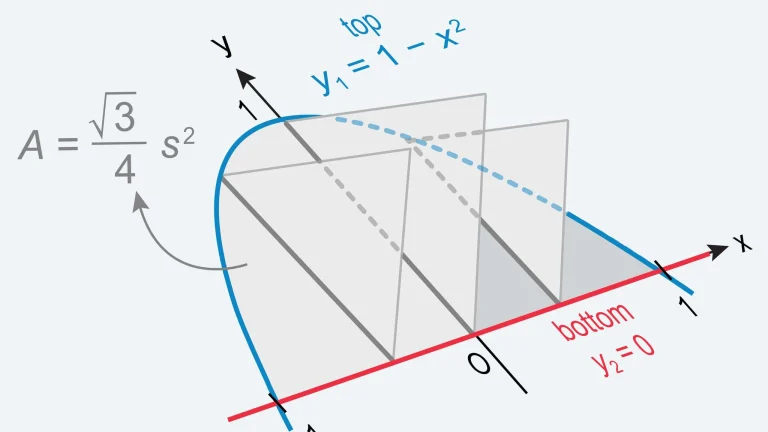Are you curious to learn about the AP Calculus BC exam format? If so, you've come to the right place. This article is your guide to the AP Calc BC exam structure.
What Is the Exam Format for AP Calculus BC?
The AP Calculus BC exam consists of two sections: multiple-choice questions (MCQs) and free-response questions (FRQs). The exam is hybrid, combining digital and handwritten components, and lasts 3 hours and 15 minutes. You’ll complete MCQs and view FRQs in the Bluebook testing app, while FRQ answers are handwritten in paper booklets. Each section contributes equally to the total exam weight.
The AP Calc BC exam format is summarized in the table below:
| Section | Question Types | No. of Questions | Time Per Section | Exam Weight |
|---|---|---|---|---|
| Section I | Multiple-Choice Questions (MCQs) | 45 | 1 hour 45 mins | 50% |
| Section II | Free-Response Questions (FRQs) | 6 | 1 hour 30 mins | 50% |
Let’s now dive deeper into each section to know what they look like.
Section I: Multiple-Choice Questions (MCQs)
The first part of your AP exam will consist of MCQs. Each question provides 4 answer options from which you need to pick the correct answer. This section has two parts:
| Section I | Part A | Part B |
|---|---|---|
| No. of Questions | 30 MCQs | 15 MCQs |
| Exam Weight | 33.3% | 16.7% |
| Time Allotted | 1 hr | 45 minutes |
| Calculator Usage | Not Permitted | Permitted |
| Question Types |
|
|
The total number of points you can score in this section is 54, with each question carrying 1.2 points. There’s no penalty for a wrong answer, so attempt all the questions. There’s always a 25% chance of guessing correctly.
Section II: Free-Response Questions (FRQs)
The second part of your AP exam consists of FRQs, which do not provide any answer choices and require you to solve the problems methodically to derive the answers. Remember to demonstrate each step that you take to deduce the solution. This section will assess your analytical and problem-solving skills. The FRQ section has two parts:
| Section II | Part A | Part B |
|---|---|---|
| No. of Questions | 2 FRQs | 4 FRQs |
| Time Allotted | 30 minutes | 1 hr |
| Exam Weight | 16.7% | 33.3% |
| Calculator Usage | Permitted | Not Permitted |
| Question Types |
|
|
You can score 54 points in this section, with each question carrying 9 points. As mentioned earlier, this section uses the "step-marking" method, meaning you’ll earn points for correctly solving each problem step. This means that even if you make a mistake after a few steps, you can still earn partial points out of 9 points per question.
Now that you’re familiar with the exam sections and format let’s move on to the types of questions and what each section tests.

Types of Questions on the AP Calculus BC Exam
The sections mentioned above include questions from all course units. However, the exam tests each course unit in distinct amounts. Let’s learn how each unit is weighted in detail to understand the AP Calc BC format better.
Multiple-choice questions (MCQs)
Section I consists of multiple-choice questions. These questions can appear from any of the ten units you learned in your AP Calculus BC curriculum. Below, you can see the weight of each unit in the MCQ section of the exam.
| Units | Unit Name | Weight |
|---|---|---|
| Unit 1 | Limits and Continuity | 4–7% |
| Unit 2 | Differentiation: Definition and Fundamental Properties | 4–7% |
| Unit 3 | Differentiation: Composite, Implicit, and Inverse Functions | 4–7% |
| Unit 4 | Contextual Applications of Differentiation | 6–9% |
| Unit 5 | Analytical Applications of Differentiation | 8–11% |
| Unit 6 | Integration and Accumulation of Change | 17–20% |
| Unit 7 | Differential Equations | 6–9% |
| Unit 8 | Applications of Integration | 6–9% |
| Unit 9 | Parametric Equations, Polar Coordinates, and Vector-Valued Functions | 11–12% |
| Unit 10 | Infinite Sequences and Series | 17–18% |
The units with higher weights tend to appear more frequently in the MCQ section, so you will likely see more questions from these units compared to others, such as Units 1 and 3. This will help you focus your study plan on these sections.
In the MCQ section, you may encounter questions with similar answer choices, which can trick you into thinking there are multiple possible correct answers. Many times, these errors are the result of rushing. Here are some tips to help you avoid such mistakes:
-
Look at the answer choices first.
Use the answer choices as clues to solve the problem. This will help you anticipate the correct answer and eliminate incorrect options, saving time.
-
Double-check your chosen answer.
Sometimes, the answer choices appear similar, but there is often a subtle difference between the correct and incorrect options. Reserve 10 minutes at the end to review your answers and correct any mistakes.
-
Come back to tricky questions later.
If you’re unsure about a question, mark it and move on. Since you only have 2-3 minutes per question, complete all the MCQs first, then revisit the difficult ones with a fresh perspective.
-
Make educated guesses even if unsure.
There's no penalty for incorrect answers, so make educated guesses. However, try eliminating as many incorrect options as possible to increase your chances of guessing correctly.
-
Assess your weaknesses during practice.
Track the questions you answer incorrectly during mock tests. Afterward, analyze the results to identify your weak areas and focus your study efforts on them. Be sure to review the explanations for any wrong answers in UWorld’s QBank, as this will help you improve for future attempts.
Do you want to learn tips and tricks that could save you time and help you ace this section? Check out our guide on how to approach AP Calculus BC Multiple-Choice Questions. In this article, we break down the MCQ section and guide you through answering each question successfully.
Free-response questions
Section II of the exam comprises free-response questions based on the 10 course units, requiring essay responses. The College Board® does not specify the relative weight of each unit in the FRQ section. However, analysis of past exams reveals that units 9 and 10 consistently appear in the FRQs, with unit 6 also being prominently featured. To best prepare, practice with past FRQs from the College Board to become familiar with the common patterns and question types.
In this section, you must solve problems and clearly demonstrate each step of your solution, as grading follows a step-marking method. At the beginning of the exam, it is advisable to read through all the questions to strategize which to address first and which to save for later. Aim to allocate about 10–12 minutes per question, ensuring you have approximately 30 minutes to tackle challenging problems and review your answers.
The AP Calculus BC exam structure is challenging. Following a disciplined study schedule with the AP Calc BC exam format knowledge, along with the right resources, such as UWorld AP Calculus BC practice questions, will help you ace the exam.
If you are curious to learn more, check out our article on how to answer AP Calculus BC FRQ. We have included a few sample questions with step-by-step instructions on solving them.
References
- AP Calculus BC. (n.d.). apcentral.collegeboard.org. Retrieved December 12, 2024, from https://apcentral.collegeboard.org/courses/ap-calculus-bc/exam
- AP Calculus AB and BC Course and Exam Description. (2020). apcentral.collegeboard.org. Retrieved December 12, 2024, from https://apcentral.collegeboard.org/media/pdf/ap-calculus-ab-and-bc-course-and-exam-description.pdf

Read More About AP Calculus BC Exam
Want to know what the AP Calculus BC CED looks like? Check out UWorld's easy-to-understand CED for in-depth info on the exam layout, skills, units, and more.
AP Calculus BC Scoring GuideCurious about how AP Calculus BC scoring works? Check out our article on AP Calc BC scoring and score distribution, including the minimum score required for college credit and placement.
AP Calculus BC Study Plan & TipsLooking for proven strategies to score a 5? Check out our expert study plan, tips, and top resources to help you ace the AP Calc BC exam and achieve the perfect score you’re aiming for.
Best AP Calculus BC Study Guide ComparisonCompare the best AP Calculus BC study guides! See how Kaplan, Barron's, and Princeton Review stack up against UWorld for comprehensive exam prep.
Best AP Calculus BC Prep Course ReviewDiscover the best AP Calculus BC prep courses! This in-depth review helps you compare options and pick the course that meets your needs.
How to Self Study for AP Calculus BCWant to ace AP Calculus BC on your own? Follow this expert self-study guide with tips, tricks, and tools to prepare effectively for the exam.



